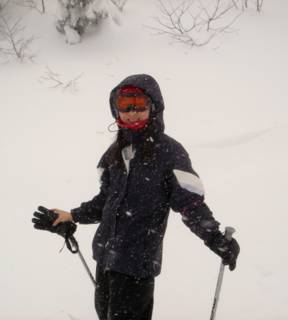 So weekday breakfasts are simple: a bowl of cereal with fresh summer berries, or a couple of slices of toasted artisan bread generously slathered with salted butter and a good jam. I’m still working my way through the jams I bought at the markets in Provence last summer and savoring every bit of it. Although I enjoy having my simple weekday breakfasts in front of the computer, I make it a point to sit down to have at least one proper breakfast every weekend. With three dogs by my feet, hubby sitting across the table from me, I don’t know a better way to spend a Sunday morning, which brings me to, my all time favorite breakfast food: almond croissant.
So weekday breakfasts are simple: a bowl of cereal with fresh summer berries, or a couple of slices of toasted artisan bread generously slathered with salted butter and a good jam. I’m still working my way through the jams I bought at the markets in Provence last summer and savoring every bit of it. Although I enjoy having my simple weekday breakfasts in front of the computer, I make it a point to sit down to have at least one proper breakfast every weekend. With three dogs by my feet, hubby sitting across the table from me, I don’t know a better way to spend a Sunday morning, which brings me to, my all time favorite breakfast food: almond croissant. I first discovered almond croissant years ago in Paris, under the Eiffel tower. As far as the ways to discover a ubiquitous Parisian pastry item, is there any better location than a neighborhood café a few blocks away from the symbol of Paris? Before my encounter with the almond croissant, a nice flaky on the outside chewy on the inside regular croissant had always been my favorite. That day, however, among all the tempting pastries lined up behind the glass counter, my eyes were drawn to an “ugly mutant” croissant. You can sort of still make out the shape of a croissant but it had a bug-like shell, and almond slices sprinkled on top. I pointed to that, stuck out my index finger and said “S'il vous plait.” Minutes later, I was biting into the most luxurious breakfast pastry you could ever dream of. Granted, it was my first trip to Paris and I hadn’t embarked on my Le Cordon Bleu journey yet so you could say I was a lot more easily impressed then, but still, I think honest good food is honest good food no matter how discerning ones’ palate is. I had an almond croissant every chance I got for the rest of our stay in Paris and loved every one of them.
I first discovered almond croissant years ago in Paris, under the Eiffel tower. As far as the ways to discover a ubiquitous Parisian pastry item, is there any better location than a neighborhood café a few blocks away from the symbol of Paris? Before my encounter with the almond croissant, a nice flaky on the outside chewy on the inside regular croissant had always been my favorite. That day, however, among all the tempting pastries lined up behind the glass counter, my eyes were drawn to an “ugly mutant” croissant. You can sort of still make out the shape of a croissant but it had a bug-like shell, and almond slices sprinkled on top. I pointed to that, stuck out my index finger and said “S'il vous plait.” Minutes later, I was biting into the most luxurious breakfast pastry you could ever dream of. Granted, it was my first trip to Paris and I hadn’t embarked on my Le Cordon Bleu journey yet so you could say I was a lot more easily impressed then, but still, I think honest good food is honest good food no matter how discerning ones’ palate is. I had an almond croissant every chance I got for the rest of our stay in Paris and loved every one of them.Back in Tokyo, I scoured every bakery in my neighborhood and found only one place that sold an interpretation of almond croissant. It was Yoku Moku, an iconic bakery on Omotesando that is famous for their petit cigare (a rolled up crepe-like cookie) of myriad flavors. The petit cigares can be found in the basement of most major department stores but the freshly baked cakes are only available at the Yoku Moku café on Omotesando. What a lot of people didn’t know was that in the morning, they put out baskets full of freshly baked pastries and among them I found a giant glazed croissant which they named almond croissant. It was vastly different from the ones I had in Paris, a more glamorous version if you would, and it was HUGE. It took Jason and I a lot of effort to chow down just that and two cups of coffee. It was also hard to come by. Over the years I was only able to buy it twice. It was always sold out, even when you go right at store opening. I suspect on some days they don’t make them.
Flash forward a couple of years and we’ve left Tokyo, escaped the humidity and air pollution of Hong Kong and ended up in Singapore again. Singapore, being humid, presents a lot of challenges to bakeries. Crusts on bread turn soggy almost the instant they hit the shelf and it’s virtually impossible to get a decent flaky croissant unless you bake it yourself.
 You would think that after so many years the almond croissant is but a distant memory, but not so, because we again had some amazing ones in a Parisian bakery called Boulangerie de Papa that supposedly had the best croissants in all of Paris. My passion was re-kindled and I was again on a quest to find the best almond croissant outside of Paris. And found it I did, in the most unlikely place.
You would think that after so many years the almond croissant is but a distant memory, but not so, because we again had some amazing ones in a Parisian bakery called Boulangerie de Papa that supposedly had the best croissants in all of Paris. My passion was re-kindled and I was again on a quest to find the best almond croissant outside of Paris. And found it I did, in the most unlikely place.We went on a holiday to Angkor Wat early this year and stayed in Hotel de la Paix for a few nights. Despite initial reservations about the hotel’s location right in the center of Siem Reap town, it turned out to be a tranquil sanctuary with tastefully decorated rooms and friendly staff.
 The best surprise, however, was the almond croissants at the breakfast buffet. I had one everyday of our stay there and bought everyone they had in the bakery the day we came back to Singapore. Sadly though, the curse of the Singapore humidity lived on. The nice crispy almond slices, along with the crunchy crust of almond paste turned soft when we brought them back home. Nonetheless, I was still happy, for Cambodia is a helluva lot closer than Paris. I was already making plans to revisit Hotel de la Paix, just so I could eat their almond croissants.
The best surprise, however, was the almond croissants at the breakfast buffet. I had one everyday of our stay there and bought everyone they had in the bakery the day we came back to Singapore. Sadly though, the curse of the Singapore humidity lived on. The nice crispy almond slices, along with the crunchy crust of almond paste turned soft when we brought them back home. Nonetheless, I was still happy, for Cambodia is a helluva lot closer than Paris. I was already making plans to revisit Hotel de la Paix, just so I could eat their almond croissants.Why don’t I just make them myself, you ask? Believe me you, that thought crosses my mind every time I obsess about almond croissants, and my pastry course at Le Cordon Bleu did cover it in one of the demo sessions. Problem is, even in Tokyo, the land of DIY pastry, I was unable to find almond syrup, an indispensable ingredient in making the almond croissant, and substituting it with anything else, thereby compromising the authenticity was, to me, unthinkable.

 So I sustain myself on memories of almond croissants I’ve had, the most recent ones being from Bouchon in Napa Valley and Tartine from San Francisco.
So I sustain myself on memories of almond croissants I’ve had, the most recent ones being from Bouchon in Napa Valley and Tartine from San Francisco.Then one day, the pastry goddess smiled upon me and told me to go into Hediard, which is just down the street from where I live but is so easy to miss that I’ve only been inside a handful of times. She told me to go all the way to the narrow hallway in the back of the store and there on the shelf, I saw, a bottle of almond syrup!
Did I run home with my precious bottle of almond syrup and make almond croissants right away? Of course not! I dug out the recipe and studied it and decided that I should start with the best croissant, which in Singapore, means frozen ones from Classic Fine Foods and baked to perfection in my own kitchen right before eating. Since almond croissants are traditionally made with day-old croissants (yes, it’s actually an ingenious way to recycle leftovers), I’d bake a few extras, eat some on day 1 and make the leftovers into almond croissants on day 2. Simple, right? Not so. It was months before I could find a weekend where we’d be eating breakfast home on Saturday (freshly baked flaky croissants) and have time on Sunday to transform the leftovers into almond croissants. You see when you’ve waited for so long to do something, you just want everything to be perfect.
The day finally came last weekend. It was Singapore’s National Day on Saturday and we were watching the Olympics at home on Sunday. So we had piping hot flaky croissants on Saturday and I made my first mini batch of almond croissants on Sunday. They had a glorious crunchy crust of sweet almond cream studded with crispy almond slices. Inside the croissant is a sweet filling of the same almond cream but it’s soft, which, combined with the subtle hint of orange blossom from the almond syrup, made it taste like something entirely different. It was perfect! Ok, maybe not perfect because I think I put too much almond cream on top so the almond slices slid off when the cream melted in the oven. But the point is, they tasted exactly the way I remembered, and now I can have them whenever I want. Is this the way to end an obsession or what!


Recipe (for six):
Six day-old croissants (the best you can find)
100g unsalted butter, softened
100g icing sugar
100g almond powder
10g flour
2 medium eggs
10g rum
almond syrup
almond slices
icing sugar
1. Sift together flour, icing sugar and almond powder
2. Whisk together butter and eggs, then whisk in flour mixture
3. Whisk in rum – this is almond cream
4. Slice croissants down in the middle without slicing through
5. Soak cut surface in almond syrup
6. Pipe some almond cream into center of croissant, close up croissant and pipe more on top
7. Sprinkle almond slices on top
8. Bake at 180C/350F for 15 minutes or until golden brown
9. Sprinkle with more icing sugar if you want.
10. Cool on rack and eat when it’s cooled but before the sugary almond crust gets soggy
























 Stumble It!
Stumble It!